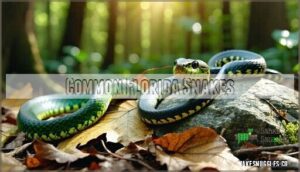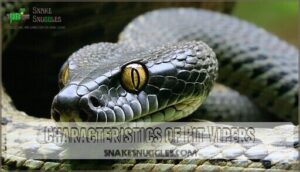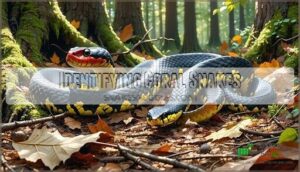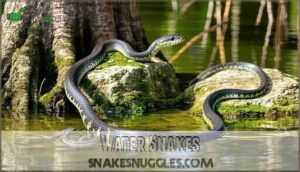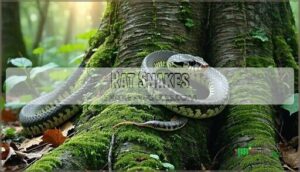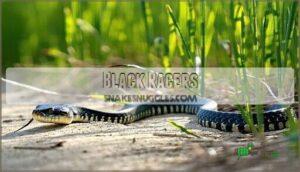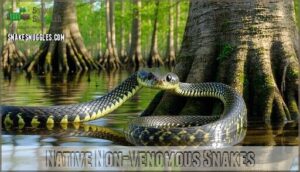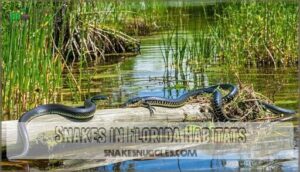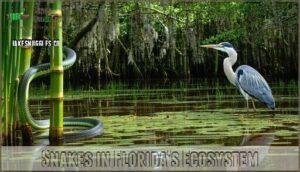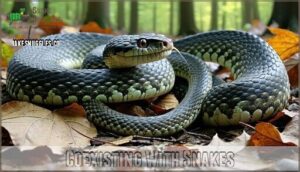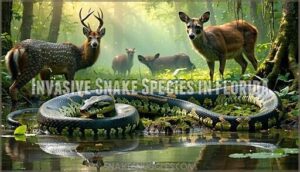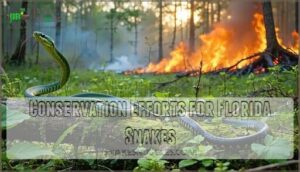This site is supported by our readers. We may earn a commission, at no cost to you, if you purchase through links.
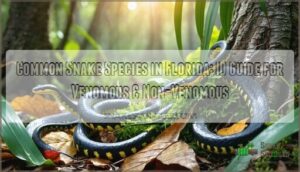
Common snake species in Florida include the swift black racer (often mistaken for a moccasin), yellow rat snake (your natural pest control), and various water snakes.
The venomous lineup features the eastern diamondback rattlesnake, cottonmouth, and coral snake with its memorable "red touches yellow, kills a fellow" pattern.
These reptiles aren’t out to get you—they’re actually keeping rodent populations in check throughout the Sunshine State.
Knowing which snakes share your neighborhood can make the difference between an unnecessary panic and a moment of wild Florida appreciation.
Table Of Contents
- Key Takeaways
- Common Florida Snakes
- Identifying Venomous Snakes
- Most Common Snakes in Florida
- Iconic Florida Snake Species
- Native Non-Venomous Snakes
- Snakes in Florida Habitats
- Snakes in Florida’s Ecosystem
- Coexisting With Snakes
- Invasive Snake Species in Florida
- Conservation Efforts for Florida Snakes
- Frequently Asked Questions (FAQs)
- Are there snakes in Florida?
- Are green snakes slender in Florida?
- Which snake is the most dangerous in Florida?
- What are the most beautiful snakes in Florida?
- Are there invasive snakes in Florida?
- What are the most resilient snakes in Florida?
- What is the most common snake found in Florida?
- How do I identify a snake I found?
- What are the 4 poisonous snakes in Florida?
- What to do if you find a snake in your yard in Florida?
- Conclusion
Key Takeaways
- You’ll find 46 native snake species in Florida, but only six are venomous – learning to identify the Eastern Diamondback Rattlesnake, Cottonmouth, and Coral Snake with its "red touches yellow, kills a fellow" pattern is essential for safety.
- Black Racers and Rat Snakes are Florida’s most common non-venomous snakes, providing valuable pest control by keeping rodent populations in check throughout urban areas and natural habitats.
- The Eastern Indigo Snake stands as Florida’s most magnificent native species – a protected, glossy blue-black beauty that can reach 5-9 feet in length and has a surprisingly docile temperament.
- Invasive species like Burmese Pythons and Boa Constrictors pose serious threats to Florida’s ecosystem, requiring ongoing control efforts while native species need conservation support to maintain healthy habitats.
Common Florida Snakes
You’ll encounter 46 native snake species throughout Florida, with only six being venomous ones that you need to identify correctly for safety.
In your backyard or while hiking Florida’s diverse landscapes, you’re more likely to meet harmless species like rat snakes and black racers that help control rodent populations than their more dangerous relatives.
Snakes Found in Urban Areas
You’ll often spot snakes in Florida’s urban areas, particularly non-venomous species like black racers and rat snakes.
These adaptable reptiles thrive in gardens, yards, and parks where they find shelter and plenty of rodents to eat.
If you encounter a snake, keep your distance and observe without disturbing it. Most urban snake encounters are harmless, but if you’re concerned, contact professional snake relocation services rather than attempting removal yourself.
Florida’s backyard snakes actually provide valuable pest control in urban environments. City parks are basically acting as snake "hotel" environments due to readily available resources, making them a snake "hotel" with a steady supply of food.
Snakes Found in Natural Spaces
Throughout Florida’s diverse natural spaces, you’ll find snakes fulfilling essential ecosystem roles. These reptiles thrive in specific habitats, from marshlands to pine forests.
When exploring these areas, remember:
- Most species avoid human contact when possible
- Snakes regulate rodent populations, benefiting the ecosystem
- Different habitats support unique snake species adapted to those environments
- Conservation efforts protect native snake populations from habitat loss
Always maintain a respectful distance when encountering these remarkable Florida snake species, which play a crucial role in native snake populations.
Identifying Venomous Snakes
You’ll find six venomous snake species in Florida, including five pit vipers with triangular heads and heat-sensing pits, plus the striking coral snake with its distinctive red, yellow, and black bands.
Learning to identify these specific traits, such as vertical pupils in pit vipers and the "red touches yellow" pattern of coral snakes, can help you stay safe during outdoor activities, by recognizing key characteristics like heat-sensing pits.
Characteristics of Pit Vipers
Five venomous pit vipers inhabit Florida, all sharing distinctive features you’ll need to recognize.
They’re equipped with heat-sensing pits between their eyes and nostrils, allowing them to detect prey’s body heat.
You’ll notice their broad, triangular heads and vertical slit pupils, unlike the round pupils of non-venomous species.
| Feature | Description | Safety Significance |
|---|---|---|
| Heat-sensing pits | Located between eye and nostril | Helps snake detect warm-blooded prey |
| Triangular heads | Wider at back than front | Contains venom glands |
| Vertical pupils | Cat-like eye slits | Indicates venomous species |
Identifying Coral Snakes
Unlike pit vipers with their triangular heads, Eastern Coral Snakes in Florida display striking red, yellow, and black bands. You’ll recognize these highly venomous snakes by the "red on yellow" pattern – remember the rhyme: "Red touch yellow, kill a fellow."
I’ll create a short, engaging blockquote in the same tone as the paragraph about coral snakes:
Remember: when red touches yellow, you’ve spotted Florida’s deadliest snake—not just a colorful fellow!
Complete belly bands are a key identifier.
- Coral snakes possess potent neurotoxic venom that can be life-threatening
- They’re often confused with harmless coral snake mimics
- They prefer hiding under debris and logs in pine woodlands
- First aid for bites requires immediate medical attention
- Their habitat variation includes sandy areas and suburban gardens
Most Common Snakes in Florida
You’ll encounter water snakes, rat snakes, and black racers most frequently during outdoor activities in Florida, as these common species make up a significant portion of the state’s 46 native snake populations.
While exploring Florida’s diverse habitats, from wetlands to pine forests, you’re likely to spot these generally harmless reptiles going about their business of controlling rodent populations and maintaining ecosystem balance.
Water Snakes
Florida’s water snakes are completely harmless despite their intimidating appearance.
You’ll find these nonvenomous reptiles throughout the state’s wetlands.
Common species include the banded watersnake, Florida green watersnake, and brown water snake, each with distinct habitat preferences and identification features.
One should also be aware that some snakes are venomous in Florida.
| Species | Identification Tip |
|---|---|
| Banded Watersnake | Dark crossbands on body |
| Florida Green | Speckled back, no distinct pattern |
| Brown Water Snake | Square dorsal blotches |
| Southern Water Snake | Dark stripe from eye to jaw |
| Saltmarsh Snake | Dark stripes along body |
Rat Snakes
Rat snakes rank among Florida’s most beneficial reptiles, serving as nature’s pest control specialists.
You’ll often spot these non-venomous eastern ratsnakes in forests, farmlands, and even suburban areas.
- Rat snake diet consists primarily of rodents, birds, and eggs
- Their climbing ability allows them to access various habitats, from tree canopies to attics
- Despite their large size (up to 6 feet), these harmless constrictors typically flee when encountered, making them a harmless part of the ecosystem, and their role is essential as nature’s pest control.
Black Racers
While rat snakes showcase vibrant colors, the sleek black racer presents a striking contrast with its jet-black body and white chin.
You’ll often spot these common Florida snakes darting through grasslands at impressive speeds (up to 3.5 mph).
Black racers prefer a diet of insects, lizards, and small rodents, and when encountered, they’ll likely flee rather than confront you.
Admire these beneficial snake species from a distance—they’re simply going about their racer business.
Iconic Florida Snake Species
You’ll find Florida’s most distinctive snakes, including the impressive Eastern Indigo, the colorful Rainbow Snake, and the striking Mud Snake, in various habitats throughout the state.
These iconic species showcase the remarkable diversity of Florida’s snake population, with each displaying unique characteristics that make them stand out among the 46 native species, highlighting the state’s remarkable diversity.
Eastern Indigo Snake
The Eastern Indigo Snake stands as Florida’s most magnificent serpent species.
This glossy blue-black beauty is the longest native snake in the United States, reaching impressive 5-9 foot lengths.
When identifying this protected species, look for:
- Uniform glossy black coloration with blue or purple iridescence in sunlight
- Reddish or orange coloration on the chin and throat
- Thick, muscular body with smooth scales
- Docile temperament when encountered
Despite being a powerful predator that even consumes venomous snakes, the Eastern Indigo has a gentle temperament.
Its threatened conservation status requires habitat preservation efforts to guarantee survival of this iconic Florida species.
Rainbow Snakes
You’ll occasionally spot the magnificent Rainbow Snake in Florida’s wetlands, instantly recognizable by its striking blue-black body adorned with vivid red stripes.
These secretive creatures:
- Prefer Rainbow habitats near freshwater with abundant eels, their primary diet
- Display gentle Rainbow behavior, rarely biting when handled despite common myths
- Face habitat threats requiring focused conservation efforts
Though elusive, their distinctive pattern makes Rainbow snake identification straightforward when encountered during your wetland explorations.
Mud Snakes
Beneath Florida’s swamps, mudsnakes thrive in their secretive habitats.
These nonvenomous snakes have glossy black scales and vivid, red-patterned bellies, making them stand out in Florida wildlife.
With a diet focused on giant salamanders, they play a unique role in snake habitats.
Shy by nature, their behavior guarantees you’re unlikely to encounter them often.
Remember, myths about mudsnakes biting their tails aren’t true.
Appreciate their importance to conservation and always follow proper snake identification and safety guidelines.
Native Non-Venomous Snakes
You’ll find Florida’s native non-venomous snakes in a variety of habitats, from marshes to forests.
These species, like the Midland Water Snake and Southern Watersnake, play important roles in maintaining healthy ecosystems and are completely harmless to humans.
Midland Water Snake
The Midland Watersnake is a fascinating native of Florida’s western panhandle, often spotted basking near streams and swamps.
Known for their blotchy neck patterns and "whiskered" scales, they’re expert fish and amphibian hunters.
These Florida reptiles give live birth, making their behavior patterns unique.
Though non-venomous, they play a valuable role in snake habitats, contributing to ecosystem balance.
Plain-bellied Watersnake
The Plain-bellied Watersnake, a nonvenomous Florida reptile, loves freshwater habitats but basks on land too.
Its greenish-gray or reddish-brown body with a plain yellow or reddish-orange belly makes snake identification straightforward.
Feeding on frogs and fish, this common snake balances ecosystems.
Respect their space—these harmless yet essential snakes deserve conservation and play a key role in Florida’s wetlands.
Southern Watersnake
The Southern Watersnake is a non-venomous marvel of Florida’s freshwater habitats.
It thrives by preying on fish and amphibians, helping ecosystems stay balanced. You’ll often spot it basking on sunny shorelines.
Non-venomous snakes play a vital role in their ecosystems.
- Diet: Primarily fish and amphibians.
- Behavior: Active at night, especially in warmer months.
- Conservation: Stable population across most regions.
Snakes in Florida Habitats
You’ll find snakes in nearly every habitat across Florida, from lush wetlands to sandy pine forests.
They’ve adapted to their surroundings, playing important roles in each ecosystem while often staying hidden from view.
Snakes in Freshwater Habitats
Florida’s freshwater ecosystems are teeming with fascinating species like the Southern Watersnake, thriving in ponds and swamps.
These common snakes excel at amphibian predation, helping maintain floodplain ecosystems. However, habitat degradation and water quality issues threaten their existence.
Here’s a quick look:
| Snake | Length | Coloration | Habitat | Diet |
|---|---|---|---|---|
| Southern Watersnake | 2-4 ft | Gray, brown | Swamps, ditches | Frogs, fish |
| Midland Water Snake | 2-4 ft | Light gray, blotches | Rivers, streams | Amphibians |
| Florida Green Watersnake | 3-4.5 ft | Green, orangish | Lakes, canals | Fish |
| Banded Water Snake | 2-3.5 ft | Yellow, brown bands | Wetlands | Amphibians |
| Brown Watersnake | 3-5 ft | Brown | Trees near water | Fish |
Snakes in Dry Land Habitats
Leaving Florida’s wetlands, you’ll find common snakes thriving in upland regions like pine flatwoods and scrub habitats.
These dry forest snakes, including the impressive Eastern Indigo Snake, adapt beautifully to sandy soils.
They’re experts in rodent control, helping agriculture and natural ecosystems.
Nonvenomous species here excel at burrowing, blending perfectly into their environment.
Habitat loss pressures these upland snake species, but their clever survival skills keep them going.
With basic snake identification, you can appreciate their roles without fear—just respect.
Snakes in Florida’s Ecosystem
You mightn’t realize it, but snakes play a huge role in Florida’s ecosystems by keeping rodent populations in check.
They also serve as a vital food source for birds, mammals, and other predators, balancing the food chain.
Role of Snakes in Controlling Rodent Populations
Snakes are nature’s rodent exterminators, keeping ecosystems in balance.
By preying on rats and mice, they prevent overpopulation and reduce the need for harmful rodenticides.
Here’s how they help:
- Protect crops from damage caused by hungry rodents.
- Curb disease spread, like hantavirus and leptospirosis.
- Minimize pest infestations near your home.
- Prevent resource competition in wildlife habitats.
Snakes as Prey for Other Predators
Hawks, eagles, and even mammals like raccoons or bobcats love a slithery snack, proving snakes aren’t just predators—they’re prey too.
In Florida’s ecosystem, avian predators swoop in for smaller snakes; mammalian predators stalk larger species, while reptiles and amphibians take their chances on young or injured ones.
Even invertebrate predators like big spiders join the hunt, and these predator-prey relationships keep the snake ecosystem in balance, reminding us how every species plays a role in nature’s intricate web of survival.
Coexisting With Snakes
You can safely share Florida’s outdoors with snakes by learning how to identify and avoid them.
Knowing what to do during an encounter helps protect you and the snakes, keeping nature’s balance intact.
Safety Precautions in Snake Habitats
When exploring snake habitats, knowing the terrain can save you trouble.
Trail awareness means sticking to clear paths and avoiding tall grass or rock piles where snakes hide.
Always wear protective gear, like sturdy boots, to guard against accidental snake bites.
Selecting appropriate footwear, like durable bite-resistant options, is essential for safety.
Practice snake safety by keeping your hands and feet out of unseen areas—rocks and logs are prime snake homes.
Respect their space if you see one.
Most snakes, even venomous species, prefer to escape than fight.
For pet safety, leash pets to prevent curious encounters.
Preparedness, including basic first aid knowledge, makes outdoor adventures safer and stress-free.
What to Do if You Encounter a Snake
If you spot a snake, don’t panic—take a deep breath and follow these steps:
- Stay calm and keep your distance: Slowly step back, letting the snake move away naturally.
- Avoid provoking it: Don’t touch or corner the snake—this prevents bites.
- Call experts if needed: For tricky encounters, reach out to professionals for snake removal. Consider using specialized handling tools for safe snake relocation.
Invasive Snake Species in Florida
Invasive snake species like Burmese pythons and boa constrictors are causing serious problems for Florida’s ecosystems. These reptiles, often released by humans, outcompete native wildlife, leading to long-term ecological damage.
Burmese Pythons
In Florida’s Everglades, the Burmese python is a massive invasive species wreaking havoc on local ecosystems.
Introduced from the pet trade, these snakes disrupt Python Ecology by preying on native animals like raccoons and bobcats.
Efforts for Python Control include hunting programs and reporting sightings to authorities for removal.
To safeguard your space, try using snake repellents.
Spotting these giants can be a surprise, but quick action helps protect Florida ecosystems.
Stay aware with resources like snake identification guides and conservation tools.
Boa Constrictors
Boa constrictors, introduced through the pet trade, thrive in South Florida’s subtropical climate.
These constrictors silently climb Florida’s invasive species list, threatening native wildlife.
Here’s what you should know:
- Boa habitats: Thrive in urban and natural areas.
- Boa diet: Small mammals and birds.
- Snake identification: Tan with dark blotches.
- Boa impact: Compete with natives.
- Boa conservation: Ownership permits regulate populations.
Anacondas
Anacondas, among the largest snakes, aren’t native to Florida but could disrupt ecosystems if released.
Preferring watery environments similar to their tropical homes, their diet includes deer and pigs, making them a wildlife threat.
With sizes rivaling Burmese pythons, these invasive species demand expert handling.
Spot one? Stay back, identify it, and let wildlife professionals manage the situation.
Conservation Efforts for Florida Snakes
You can play a big role in protecting Florida’s native snakes, which are essential for healthy ecosystems.
By supporting efforts to control invasive species like pythons, you’re helping give native snakes a fighting chance to thrive, which is crucial for maintaining healthy ecosystems.
Protecting Native Snake Species
While invasive species harm Florida’s ecosystem, protecting our native snakes is equally important.
You can help through habitat preservation efforts that maintain natural snake environments. Support snake conservation by learning about local species – education reduces fear and promotes responsible coexistence.
Join snake protection initiatives that preserve genetic diversity. Consider volunteering with wildlife agencies for snake habitat restoration projects.
Every action toward snake ecology protection helps these valuable reptiles thrive against growing threats to their survival.
Controlling Invasive Snake Populations
While protecting native snakes is essential, controlling invasive species presents different challenges.
You’ll find that managing invasive snake populations in Florida requires multiple approaches. Burmese pythons, boa constrictors, and anacondas threaten native wildlife through predation and competition.
Public awareness campaigns and bounty programs help address these ecological impacts. Prevention strategies like stricter pet ownership regulations and AI-based detection systems show promise.
Research funding supports innovative snake management techniques, including environmental DNA monitoring. Effective control can include specialized snake traps.
Community involvement remains key to successful invasive species control efforts, and multiple approaches are necessary for managing invasive snake populations, which requires innovative techniques and effective control methods, including public awareness campaigns.
Frequently Asked Questions (FAQs)
Are there snakes in Florida?
Like the backdrop of a wild adventure movie, Florida’s landscape is teeming with snakes. You’ll find 46 native species, including six venomous ones, thriving in the state’s diverse ecosystems.
Are green snakes slender in Florida?
Yes, you’ll find that Florida’s green snakes are quite slender. They’re known for their pencil-thin bodies, rarely exceeding 2 feet in length, making them distinctive among the state’s diverse snake population.
Which snake is the most dangerous in Florida?
The Eastern Diamondback Rattlesnake is Florida’s most dangerous snake.
You’ll recognize it by its diamond pattern and large size.
It has potent venom and requires immediate medical attention if you’re bitten.
What are the most beautiful snakes in Florida?
Florida’s colorful Rainbow Snake with its striking red stripes and the vibrant Scarlet Kingsnake showcase nature’s artistry.
You’ll also admire the Eastern Indigo’s glossy blue-black scales and the Corn Snake’s brilliant orange patterns.
Are there invasive snakes in Florida?
Indeed, you’ll find four non-native snake species that have invaded Florida.
They thrive in Florida’s warm climate, which has allowed three species, including the notorious Burmese Python, to establish breeding populations.
The Burmese Python is wreaking havoc on Everglades wildlife.
What are the most resilient snakes in Florida?
Among Florida’s 46 native snake species, the Black Racer and Eastern Ratsnake are considered most resilient, adapting to various habitats from urban areas to forests.
You’ll often find these hardy survivors thriving despite habitat changes, which makes them a notable example of resilient species.
What is the most common snake found in Florida?
When you’re out hiking in Florida, you’ll likely encounter the Black Racer (Coluber constrictor) more than any other snake. They’re non-venomous, fast-moving, and found throughout the state in various habitats.
How do I identify a snake I found?
To identify a snake, observe its color pattern, head shape, and size from a safe distance.
Note any rattles, bands, or distinctive markings.
You’ll want to photograph it, if possible, for expert identification.
What are the 4 poisonous snakes in Florida?
Florida’s deadly quartet slithers through the wilderness: Eastern Diamondback Rattlesnake, Timber Rattlesnake, Florida Cottonmouth (water moccasin), and Eastern Coral Snake. You’ll want to learn their distinct markings for your safety.
What to do if you find a snake in your yard in Florida?
Stay calm and back away slowly from the snake.
Don’t attempt to kill or handle it. Call a professional wildlife remover if it’s near your home.
Most Florida snakes are harmless.
Conclusion
Imagine this scenario: you’re gardening when suddenly you spot a snake slithering nearby.
Instead of panicking, you recognize it as a harmless black racer—one of the common snake species in Florida.
By familiarizing yourself with Florida’s diverse serpents, you’ll appreciate these beneficial creatures rather than fear them.
Remember, most common snake species in Florida are non-venomous and help maintain ecological balance.
When in doubt, keep your distance and let these remarkable reptiles continue their important work in nature.

